Reading List
The most recent articles from a list of feeds I subscribe to.
Let's Compare All Three Versions Of Dragon Quest VII, Including Reimagined
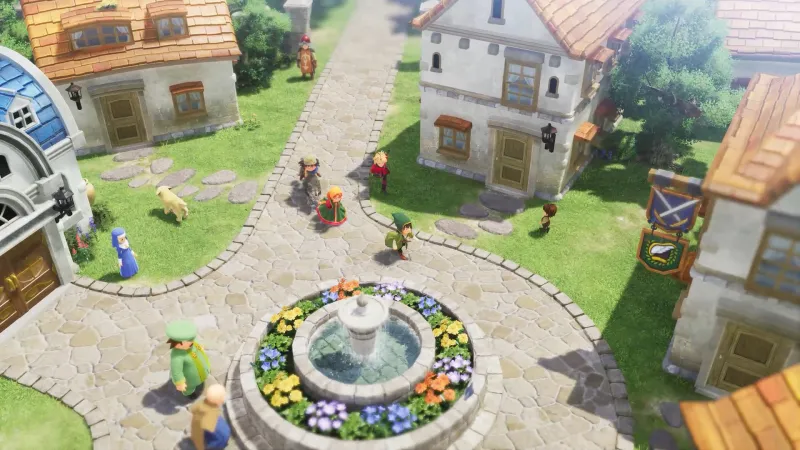
Dragon Quest VII Reimagined is the latest game to grace the cover of Game Informer, and you can read all about that here. If you're familiar with the history of this specific Dragon Quest entry, then you likely already know Reimagined is the second time Square Enix has remade Dragon Quest VII.
It released the original Dragon Quest VII in 2000 on PlayStation in Japan and a year later as Dragon Warrior VII in the U.S. Square Enix remade it for the Nintendo 3DS, launching Dragon Quest VII: Fragments of the Forgotten Past in 2013 in Japan before releasing it in the West in 2016. Now, Square Enix is remaking it a second time, with Reimagined launching next year on PlayStation 5, Xbox Series X/S, Switch 2, Switch, and PC.
It's rare to see a single entry get this many remakes, so we've created two galleries to show you the differences between the original Dragon Quest VII, the 3DS remake, and Reimagined, using the same spot across the years.
Gallery 1: Original vs. 3DS Remake vs. Reimagined
Gallery 2: Original vs. 3DS Remake vs. Reimagined
As you can see, the differences are pretty stark due to hardware limitations and varying visual styles and aesthetics. We're excited for Reimagined, though, and you can read about why in the Game Informer cover story here, and if you aren't already a subscriber, be sure to subscribe here.
Which visual style for Dragon Quest VII do you like best? Let us know in the comments below!
Kirby Air Riders Review - Star Ships We’re Meant To Fly

Reviewed on:
Switch 2
Platform:
Publisher:
Nintendo
Developer:
Bandai Namco, Sora, Ltd
Release:
Rating:
Everyone 10+
“Waddle Doo!” I cheer at the top of my lungs. I just lost an online race in Kirby Air Riders, but I couldn't be happier. All week, I’ve been trying to unlock Waddle Doo by using a specific item in a specific mode, and have been so unlucky in finding it that this otherwise insignificant race has become a massive achievement. Kirby Air Riders, the latest from beloved game director Masahiro Sakurai, is filled with moments like this. The game overflows with his signature style, making bold creative choices even if it limits the game’s appeal to a slightly narrower audience.
The original Kirby Air Ride on GameCube is a racing game that uses just one button, and the sequel adds a (rarely used) second button. These barebones controls imply that the gameplay is similarly simple, or perhaps even boring, but that couldn’t be further from the truth. Because the B button drifts, charges a boost, inhales enemies, uses copy abilities, and drops you mid-air, the timing and duration requirements are precise. Anyone could pick up Kirby Air Riders and get to the end of a race, but it takes a few races to get the hang of it, and the skill ceiling is sky high.
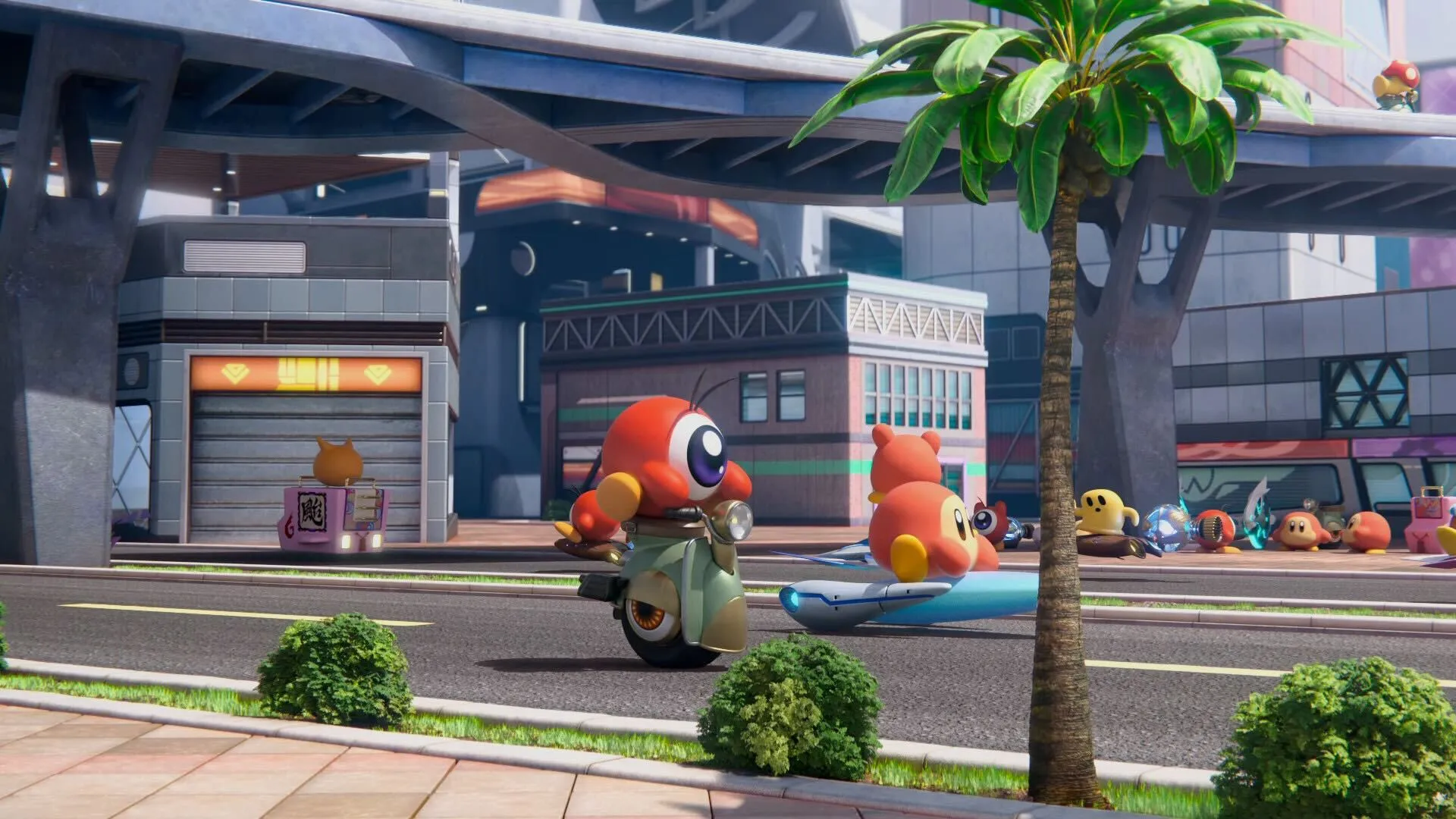
Machines also come in several categories – stars, wheelies, and tanks, to name a few – and they all drive differently. Even among these categories, each machine has different stats (of which there are nine) and bespoke abilities, which can range from getting unique boosts to completely reworking the drift mechanics. The same is true for the game’s roster of 20+ playable riders, which combs every inch of Kirby’s lore for characters. For every Meta Knight and Waddle Dee, there’s a Scarfy or a Rick, and you will undoubtedly learn the names of Kirby enemies you've seen a million times and never thought more deeply about. Riders also have unique stats and abilities, along with their own special ability that charges up during a race.
While it’s a boon for Kirby fans and those who like unlockables, this huge variety can make the game overwhelming to new players. In single player, the rider and machine select screens show stats and abilities for each option, but once you add more than one player in the mix, it creates a condensed, Smash Bros.-like select screen that hides the finer details. Unless you warn a friend that the cool-looking Bulk Star has a unique acceleration mechanic, they’ll hop into the game and be confused as to why they aren't moving. The right machine can make a massive difference, and if I hadn’t been the one to unlock them, I’d be frustrated trying to find the one right for me without seeing a tutorial.
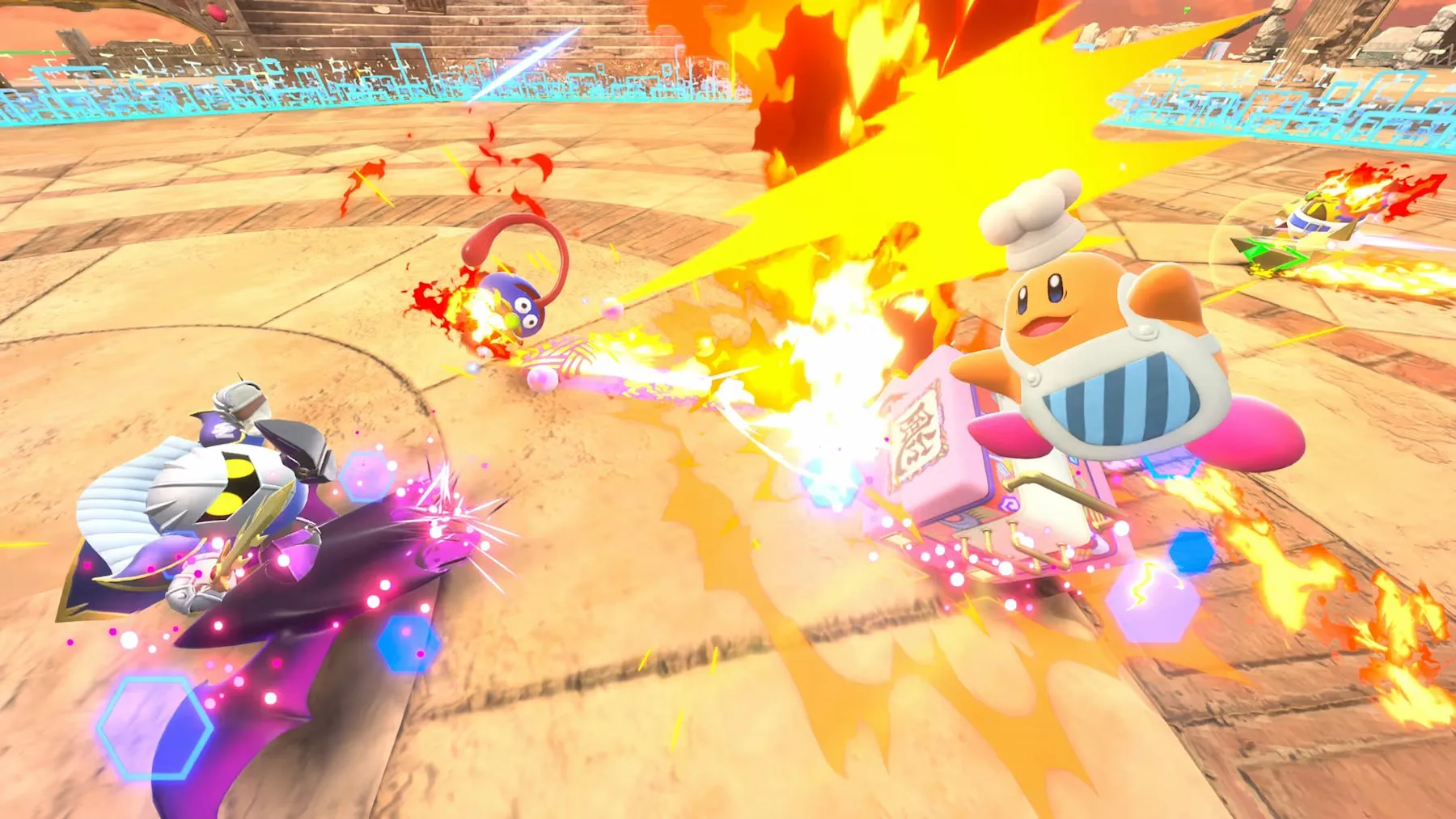
These riders and machines can be used in one of four main modes. Air Ride is a standard race, with six riders and a series of gorgeously designed tracks, each of which bombards you with color, style, and catchy soundtracks. Top Ride is a condensed, top-down view of the game that simplifies the controls even further, and while I initially wrote it off, I grew to find its bite-sized competition exciting. City Trial is a longer competition, with players exploring an open map to collect upgrades before a big event at the end, which can include races, battles, gliding challenges, cooperative boss fights, and much more. Of the included modes, it’s my least favorite to play alone, as the repeated city exploration gets stale after a while. You can play any of the aforementioned modes online, but be prepared to wait. It typically takes a few minutes to be placed into a match of any kind, and I spent more time waiting than actually playing.
Finally, there’s Road Trip, Kirby Air Riders’ solo story mode. Like all Kirby lore, it starts cute and whimsical and somehow ends up dark and apocalyptic, a tone I greatly enjoy. In Road Trip, the player travels long stretches of highway, encountering micro-challenges along the way, like the stadium challenges at the end of City Trial, all while being pursued by the mysterious Noir Dedede. It only takes about two hours to complete, but I almost can’t imagine doing it all in one sitting. The pace of minigames is relentless, and by the end, they bleed together and feel a bit repetitive. Still, it’s a mode worth checking out, as it’s arguably the best time I’ve had with Kirby Air Riders while playing solo.
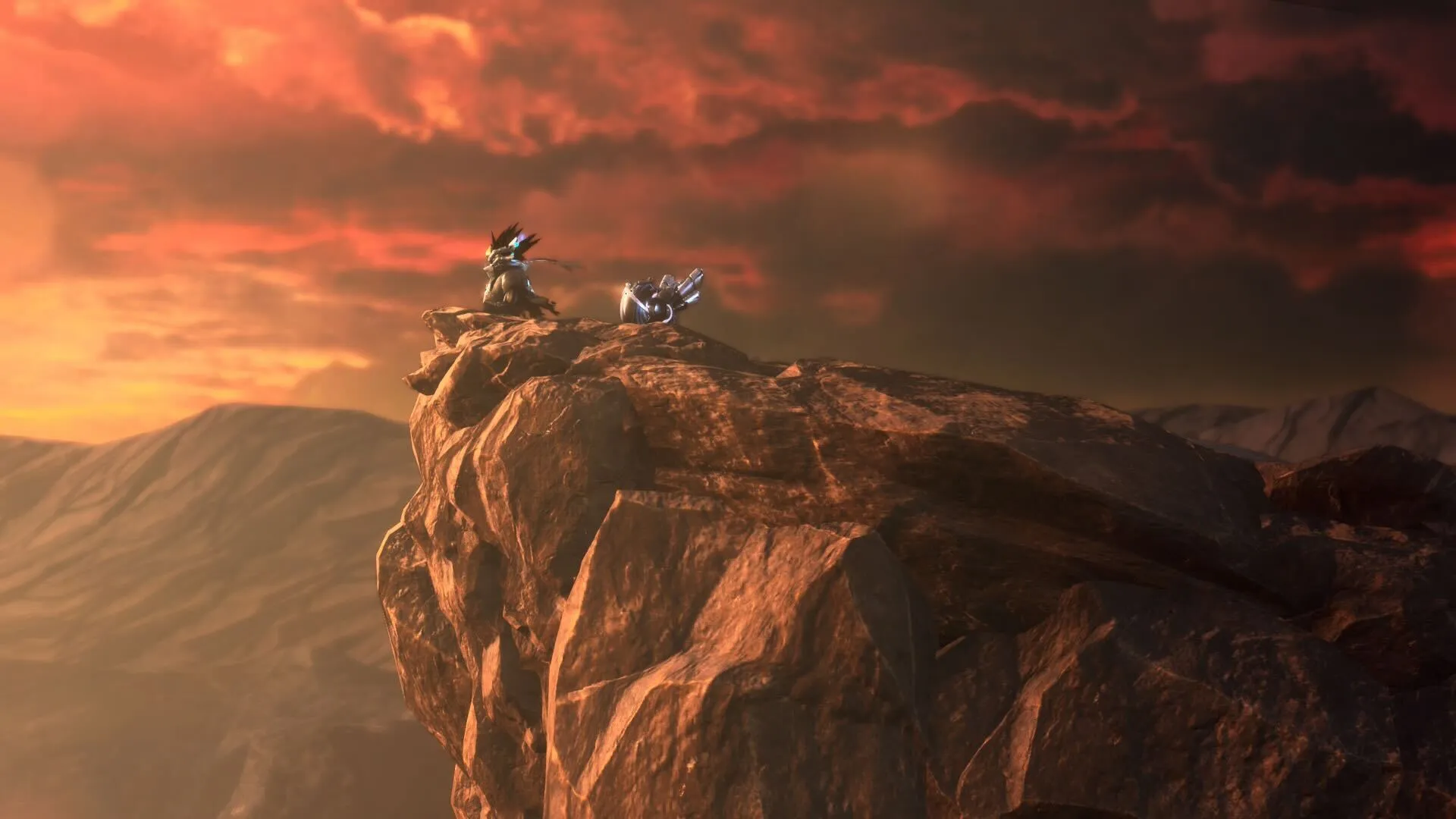
The game’s wealth of achievements and unlockables is my other favorite part. There are hundreds of challenges, divided up by game mode, for the player to complete, with unlocks ranging from stickers and decals to courses, riders, and machines. The first dozen races in any mode are almost guaranteed to complete a handful of goals, and after that, it gives constant reason to go back and try another course or another rider one more time. Having so much to unlock is nostalgic, as many modern multiplayer games aim to even the playing field and get you competitively viable as soon as possible. It also makes you appreciate each of the game’s elements a little more, since they’re unlocked one at a time. I don’t think I would have cheered “Waddle Doo!” the way I did when I unlocked them if they had been an option in the character select screen from the start.
Kirby Air Riders is an inflexible experience, forcing the player to learn its mechanics and engage with all its modes to get the most out of it, and it’s a better game for it. Its gameplay is simple to learn but hard to master, and with such a variety of machines and modes, there are a lot of different definitions of what that mastery looks like. It’s a game with a strong, unique identity that likely won’t unseat your favorite racing game, but it isn’t trying to. Kirby Air Riders is a star shining for no one but itself, and I can’t help but respect it for that.
Score: 8.5
Kirby Air Riders Review - Star Ships Were Meant To Ride

Reviewed on:
Switch 2
Platform:
Publisher:
Nintendo
Developer:
Bandai Namco, Sora, Ltd
Release:
Rating:
Everyone 10+
"Waddle Doo!" I cheer at the top of my lungs. I just lost an online race in Kirby Air Riders, but I couldn't be happier. All week, I've been trying to unlock Waddle Doo by using a specific item in a specific mode, and have been so unlucky in finding it that this otherwise insignificant race has become a massive achievement. Kirby Air Riders, the latest from beloved game director Masahiro Sakurai, is filled with moments like this. The game overflows with his signature style, making bold creative choices even if it limits the game's appeal to a slightly narrower audience.
The original Kirby Air Ride on GameCube is a racing game that uses just one button, and the sequel adds a (rarely used) second button. These barebones controls imply that the gameplay is similarly simple, or perhaps even boring, but that couldn't be further from the truth. Because the B button drifts, charges a boost, inhales enemies, uses copy abilities, and drops you mid-air, the timing and duration requirements are precise. Anyone could pick up Kirby Air Riders and get to the end of a race, but it takes a few races to get the hang of it, and the skill ceiling is sky high.

Machines also come in several categories – stars, wheelies, and tanks, to name a few – and they all drive differently. Even among these categories, each machine has different stats (of which there are nine) and bespoke abilities, which can range from getting unique boosts to completely reworking the drift mechanics. The same is true for the game's roster of 20+ playable riders, which combs every inch of Kirby's lore for characters. For every Meta Knight and Waddle Dee, there's a Scarfy or a Rick, and you will undoubtedly learn the names of Kirby enemies you've seen a million times and never thought more deeply about. Riders also have unique stats and abilities, along with their own special ability that charges up during a race.
While it's a boon for Kirby fans and those who like unlockables, this huge variety can make the game overwhelming to new players. In single player, the rider and machine select screens show stats and abilities for each option, but once you add more than one player in the mix, it creates a condensed, Smash Bros.-like select screen that hides the finer details. Unless you warn a friend that the cool-looking Bulk Star has a unique acceleration mechanic, they'll hop into the game and be confused as to why they aren't moving. The right machine can make a massive difference, and if I hadn't been the one to unlock them, I'd be frustrated trying to find the one right for me without seeing a tutorial.

These riders and machines can be used in one of four main modes. Air Ride is a standard race, with six riders and a series of gorgeously designed tracks, each of which bombards you with color, style, and catchy soundtracks. Top Ride is a condensed, top-down view of the game that simplifies the controls even further, and while I initially wrote it off, I grew to find its bite-sized competition exciting. City Trial is a longer competition, with players exploring an open map to collect upgrades before a big event at the end, which can include races, battles, gliding challenges, cooperative boss fights, and much more. Of the included modes, it's my least favorite to play alone, as the repeated city exploration gets stale after a while. You can play any of the aforementioned modes online, but be prepared to wait. It typically takes a few minutes to be placed into a match of any kind, and I spent more time waiting than actually playing.
Finally, there's Road Trip, Kirby Air Riders' solo story mode. Like all Kirby lore, it starts cute and whimsical and somehow ends up dark and apocalyptic, a tone I greatly enjoy. In Road Trip, the player travels long stretches of highway, encountering micro-challenges along the way, like the stadium challenges at the end of City Trial, all while being pursued by the mysterious Noir Dedede. It only takes about two hours to complete, but I almost can't imagine doing it all in one sitting. The pace of minigames is relentless, and by the end, they bleed together and feel a bit repetitive. Still, it's a mode worth checking out, as it's arguably the best time I've had with Kirby Air Riders while playing solo.

The game's wealth of achievements and unlockables is my other favorite part. There are hundreds of challenges, divided up by game mode, for the player to complete, with unlocks ranging from stickers and decals to courses, riders, and machines. The first dozen races in any mode are almost guaranteed to complete a handful of goals, and after that, it gives constant reason to go back and try another course or another rider one more time. Having so much to unlock is nostalgic, as many modern multiplayer games aim to even the playing field and get you competitively viable as soon as possible. It also makes you appreciate each of the game's elements a little more, since they're unlocked one at a time. I don’t think I would have cheered "Waddle Doo!" the way I did when I unlocked them if they had been an option in the character select screen from the start.
Kirby Air Riders is an inflexible experience, forcing the player to learn its mechanics and engage with all its modes to get the most out of it, and it's a better game for it. Its gameplay is simple to learn but hard to master, and with such a variety of machines and modes, there are a lot of different definitions of what that mastery looks like. It's a game with a strong, unique identity that likely won't unseat your favorite racing game, but it isn't trying to. Kirby Air Riders is a star shining for no one but itself, and I can't help but respect it for that.
Score: 8.5
The Games You Should Play Over The Holidays | The Game Informer Show
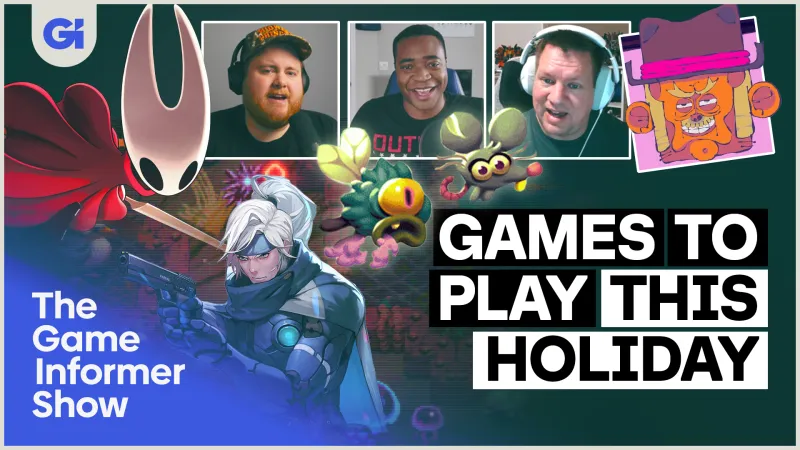
In light of that, we're publishing a special early edition of The Game Informer Show this week with a little twist - rather than a roundtable discussion, we had everyone contribute their own solo take on what they're playing, thinking about, or otherwise getting back into this holiday break! From the 2025 backlog to older games, and even some tabletop options, we've got a boatload of personalized selections from the GI crew. Enjoy!
The Game Informer Show is a weekly podcast covering the video game industry. Join us every Friday for chats about your favorite titles – past and present – alongside Game Informer staff and special guests from around the industry.
Watch the video version here:
Listen to "The Games You Should Play Over The Holidays" on Spreaker.Jump to a section using these timestamps:
00:00 - Intro
01:10 - Matt Miller's Picks
13:12 - Marcus Stewart's Picks
15:57 - Kyle Hilliard's Picks
24:41 - Alex Van Aken's Picks
33:47 - Charles Harte's Picks
37:44 - Eric Van Allen's Picks
Battletoads, Ninja Gaiden II, And More Come To Nintendo Switch Online
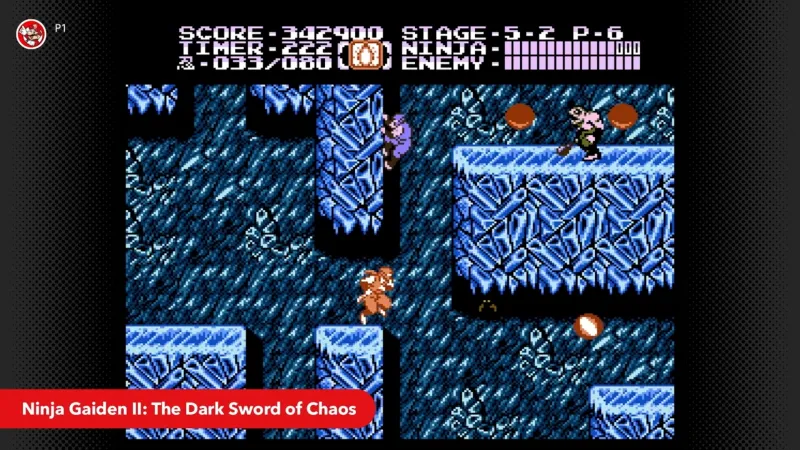
Nintendo Switch Online’s NES and Game Boy libraries got a new pair of games each today, the former for the first time in nearly a year. Battletoads and Ninja Gaiden II: The Dark Sword of Chaos are now available for the NES library, while the Game Boy collection gets Bionic Commando and Kid Icarus: Of Myths and Monsters
Battletoads, first released in 1991, is both beloved and infamous as a classic and challenging co-op brawler. Developed by Rare, it’s now technically owned by Xbox as well. Ninja Gaiden II: The Dragon Sword arrived in 1990 as the second entry of the NES trilogy of Ninja Gaiden games. You may be surprised to know that it’s a very hard game.
The Game Boy version of Bionic Commando was released in 1992 as a largely faithful port of the NES original. Its arrival on Nintendo Switch Online marks its first-ever re-release. 1991’s Kid Icarus: Of Myths and Monsters is the Game Boy exclusive sequel to Kid Icarus, and would be the last entry in the series until 2012’s Kid Icarus: Uprising.
If you’ve lost track of what’s available on the Nintendo Switch Online’s various classic games libraries, be sure to check out our complete database of every game on the service.

